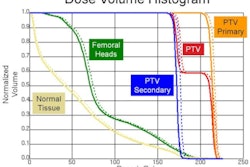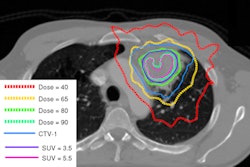Of the many treatment options for laryngeal cancer, radiation therapy by itself may cause the least toxicity and preserve the voice of a patient. But how effective will it be if used as the sole treatment? A new risk-prediction nomogram could help provide the answer.
Researchers from Maastricht University Medical Center have developed and validated the nomogram to predict the risk of cancer recurrence and death based on outcomes of nearly 1,000 patients. This is the first of a series of nomograms being developed to assess the effectiveness of different therapeutic treatments for laryngeal carcinoma (Radiotherapy and Oncology, July 22, 2011).
An estimated 28,900 cases of larynx cancer were diagnosed in 33 countries in Europe and the U.K. in 2008, according to researchers at the International Agency for Research on Cancer in Lyon, France. The American Cancer Society estimates that 12,740 cases were diagnosed in the U.S. in 2010. Mortality rates during those years were estimated at 45% and 20%, respectively.
The primary treatment for early-stage laryngeal carcinomas is radiotherapy, laser surgery, or limited surgery. Treatment for more advanced cancers includes a combination of these methods plus chemotherapy. However, treatment planning is affected by TNM classification, nodal involvement, and hemoglobin levels.
Lead author Dr. Ada Egelmeer, from Maastricht's department of radiotherapy, and colleagues hypothesized that a nomogram based on the outcomes of individual patients might be more accurate than a nomogram based on TNM classification alone. They identified 994 patients with squamous cell laryngeal carcinoma who received radiation therapy at Maastricht Radiation Oncology (Maastro) between January 1977 and December 2008. An additional 57 patients in the clinic's database were excluded because they had also received chemotherapy and/or had distant metastases.
Nearly 90% of the patients were male, and at the time of treatment, the group ranged in age from 31 to 91 years (median age, 65). Of the patients, 71% were cancer-free two years following treatment; this dropped to 54% at five years. Two-year survival was 82.8%, and five-year survival was 67.7%. Patients were followed for up to five years, with a range of one month to 72 months.
Over the 30-year time span, patients received a variety of radiation therapy treatments and doses, the majority of which were between 60 Gy and 70 Gy. The year of treatment appeared to have no significant impact on either survival or recurrence outcomes. The researchers corrected for differences in radiation schemes by calculating the biological-equivalent dose in fractions of 2 Gy, and they corrected for overall treatment time.
The prognostic factors tested were sex, age at start of radiotherapy, tumor location (glottic or nonglottic), pretreatment hemoglobin level, tumor stage, nodal stage, and the biological-equivalent dose of radiation that the patient received.
All factors except tumor location were prognostic for local control. Unfavorable prognostic factors for overall survival were low hemoglobin level, male sex, high tumor status, nodal involvement, older age, and a lower biological-equivalent radiation dose. The researchers identified 220 cancer recurrences, with more than 80% of these occurring within the first two years of treatment.
The researchers had hoped to divide patients into four groups ranging from low to high risk based on their disease, but they discovered that the two middle groups had similar prognoses. Instead, they created low-, medium-, and high-risk group prognoses.
Survival rates by risk level
|
Nomograms developed to predict local control and overall survival were tested against the Maastro clinic database of 994 patients, and also against four other institutional databases of patients who received radiotherapy only for laryngeal cancer within the 30-year time span. These included 178 patients from VU University Medical Center, 205 patients from the Netherlands Cancer Institute - Antoni van Leeuwenhoek Hospital, 109 patients from University Hospitals Leuven, and 403 patients from the Christie Hospital in Manchester, U.K.
The nomogram used for predicting local control had an accuracy range of 62% to 72%, and the nomogram for predicting overall survival had a range of 68% to 74%. The nomogram for survival prediction was significantly superior to the one based on TNM classification for four of the five patient datasets, whereas the nomogram predicting local control was only slightly better for all five.
The researchers are currently analyzing data from patients who received laser surgery or general surgery, and from patients who received surgery and postoperative radiotherapy; they plan to develop nomograms for these treatment categories. A prospective, randomized, clinical trial designed to include the collection of biomarker and imaging data should be conducted so that a sophisticated clinical decision-support model can be created, the group recommended.
The nomogram can be accessed and used online by clicking here.



















